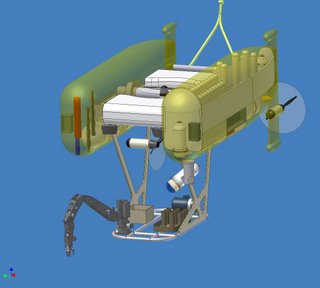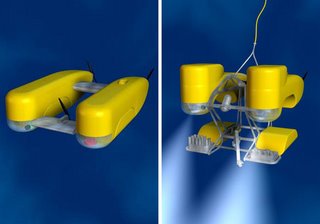 The first humans to venture into deep sea exploration were Jacques Piccard and Don Walsh in 1960.They were the first humans to touch the bottom of Challenger Deep, a underwater trench with a depth of 10924m. After that no one, man or machine has scaled such depths.Researchers at the Deep Submergence Laboratory at Woods Hole Oceanographic Institution and Johns Hopkins University have been developing a vehicle called Hybrid Remotely Operated Vehicle(HROV) that will enable scientists to perform photography,biological sampling and topographical mapping of the world's deepest underwater trench, the Challenger Deep.
The first humans to venture into deep sea exploration were Jacques Piccard and Don Walsh in 1960.They were the first humans to touch the bottom of Challenger Deep, a underwater trench with a depth of 10924m. After that no one, man or machine has scaled such depths.Researchers at the Deep Submergence Laboratory at Woods Hole Oceanographic Institution and Johns Hopkins University have been developing a vehicle called Hybrid Remotely Operated Vehicle(HROV) that will enable scientists to perform photography,biological sampling and topographical mapping of the world's deepest underwater trench, the Challenger Deep.
 The Hybrid vehicle can either be controlled form the surface of the water by a controller or it can be programmed to do a variety of tasks autonomously.The HROV will be using a micro-cable that will enable the vehicle to go deeper without the drag of heavier cables. The HROV can also run for 36 hours on batteries only.
The Hybrid vehicle can either be controlled form the surface of the water by a controller or it can be programmed to do a variety of tasks autonomously.The HROV will be using a micro-cable that will enable the vehicle to go deeper without the drag of heavier cables. The HROV can also run for 36 hours on batteries only.
The HROV's first scientific mission is planned for 2008 and one of the first missions for the HROV is to obtain data from the Mariannas Trench that will enable scientists to learn more about the mantle how much the mantle is interacting with respect to the oceanic lithosphere.
 The HROV will be able to withstand pressure from 11000m of water with the help of a state of the art ceramic material. It is highly dangerous to send humans to such depths for fear of implosions.
The HROV will be able to withstand pressure from 11000m of water with the help of a state of the art ceramic material. It is highly dangerous to send humans to such depths for fear of implosions.
The HROV is a very advance robot and it will greatly help us understand the life and geography of the deep oceans.
References:
(1)http://news.bbc.co.uk/2/hi/science/nature/3373511.stm
(2)http://www.whoi.edu/sbl/liteSite.do?litesiteid=1810
Prakash S/O Yanaprakasam
U036229B
7 comments:
WOW this is a wonderful device as it can really help humans in exploration of deep sea and find extraordinary stuff...
WOW this is a wonderful device as it can really help humans in exploration of deep sea and find extraordinary stuff...
opps forget to put my name
u046232N Ang Rongjie
One of the major use for robotics is to do things for human in the situation or environment that are dangerous. There are so many fantastic and wonderful things in the deep sea, these robots can really help us to explore them.
by U037121E Liu PengYin
This is a wonderful invention indeed, with this, scientist can now explored sea much deeper than any human can reach. More discoveries will be waiting to be made with this guy around.
by U036419B Jway Kim Soon
"The HROV's first scientific mission is planned for 2008 and one of the first missions for the HROV is to obtain data from the Mariannas Trench that will enable scientists to learn more about the mantle how much the mantle is interacting with respect to the oceanic lithosphere."
This such a great mission! Deep sea alwas remains as a myth to humans, and soon the HROV can help explore some of the truth..
U036546A Wu Lihua
I think future developments would enable this robot to carry out more specialised operations such as repair of damaged under-sea cables, maintanence of oil rigs and deep-sea exploration.
However, the main problem I can see for now would be how to maintain communications between the robot and the sea-level control centre as cables are unwieldy and impractical, and underwater sonar or wireless networks are still in their development stages.
by U037779R, Han Mingding
Very worthwhile info, lots of thanks for your article.
Post a Comment